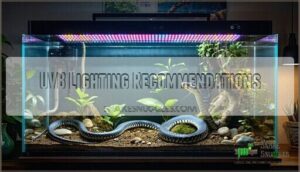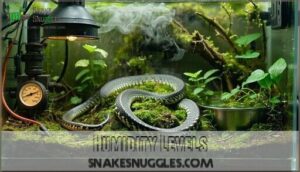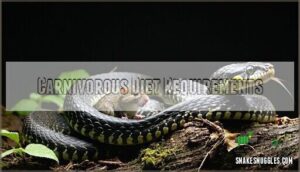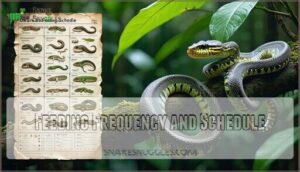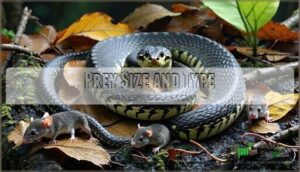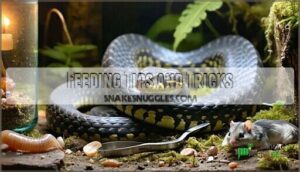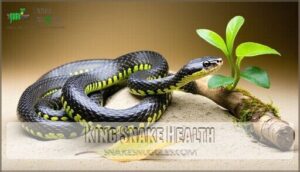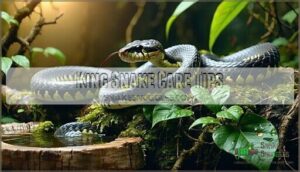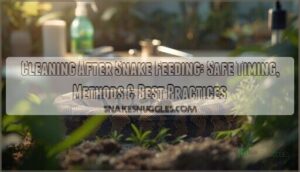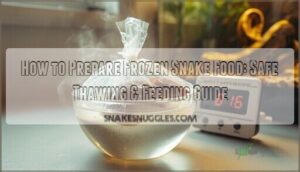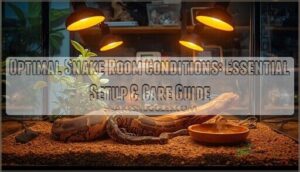This site is supported by our readers. We may earn a commission, at no cost to you, if you purchase through links.
 You’ll need proper housing, heating, and feeding to keep your king snake healthy and thriving.
You’ll need proper housing, heating, and feeding to keep your king snake healthy and thriving.
Your king snake care sheet overview should include a 40-gallon enclosure minimum, temperature gradient of 75-85°F with basking spots, and secure hiding places since these escape artists are notorious for finding weak spots in their homes.
Feed juveniles every 5-7 days and adults every 10-14 days with appropriately sized rodents.
Maintain 50-60% humidity using cypress mulch or aspen shavings, and remember that king snakes are cannibalistic, so housing them alone prevents any unfortunate roommate situations.
The secret to successful king snake ownership lies in understanding their specific behavioral quirks and environmental needs, which includes providing a proper temperature gradient and ensuring they have secure hiding places, all of which contribute to keeping your king snake healthy and thriving.
Table Of Contents
- Key Takeaways
- King Snake Habitat
- Lighting and Heating
- King Snake Diet
- King Snake Health
- King Snake Care Tips
- Frequently Asked Questions (FAQs)
- How to properly take care of a king snake?
- What is the best setup for a king snake?
- What bedding do king snakes need?
- How often do king snakes shed their skin?
- What substrates work best for king snakes?
- Can king snakes swim or climb trees?
- How long do king snakes typically live?
- When do king snakes reach sexual maturity?
- Conclusion
Key Takeaways
- You’ll need a minimum 40-gallon, escape-proof enclosure with secure lids since king snakes are notorious escape artists who’ll exploit any weakness in your setup.
- Create a proper temperature gradient from 75-85°F with basking spots reaching 85-90°F, and maintain 50-60% humidity using cypress mulch or aspen shavings.
- Feed juveniles every 5-7 days and adults every 10-14 days with appropriately sized rodents, ensuring prey doesn’t exceed 1.5 times your snake’s thickest body section.
- Never house multiple king snakes together since they’re cannibalistic and will attack and consume cage mates, requiring each snake to have its own dedicated enclosure.
King Snake Habitat
Creating a proper habitat for your king snake starts with understanding their specific space and security needs.
You’ll need an escape-proof enclosure with adequate ventilation, proper sizing based on your snake’s length, and the right environmental controls to keep your serpent healthy and stress-free.
Enclosure Size Requirements
Your king snake needs adequate space to thrive.
Adult kingsnakes require a minimum 4x2x2 foot terrarium setup, though larger enclosures promote natural behavior.
Baby snakes can start in 40-gallon tanks until reaching 36 inches long.
The enclosure dimensions should allow your snake to stretch comfortably without covering more than two-thirds the perimeter distance.
Proper snake enclosure designs often involve snake habitat systems to guarantee the health and well-being of the king snake.
Housing Multiple Snakes
Never house multiple kingsnakes together. These cannibalistic reptiles will attack and consume cage mates, including those of similar size.
Kingsnakes are solitary predators—sharing a tank means risking deadly fights and cannibalism every time.
Each snake requires its own dedicated snake enclosure to prevent cohabitation risks. Multiple enclosures eliminate snake compatibility issues entirely.
Group housing isn’t possible with kingsnakes due to their predatory nature toward other serpents, making snake socialization impossible.
Understanding the snake housing risks is essential for maintaining a healthy environment for your pets, and recognizing the importance of separate enclosures.
Escape-Proof Enclosures
Your snake’s escape-proof enclosure requires secure lids and reliable locking mechanisms to prevent costly breakouts.
King snakes are notorious escape artists who’ll exploit any weakness in your snake habitat setup.
These master escape artists will find every loose latch, gap, and weakness in your enclosure setup.
Critical Escape Prevention Features:
- Screen tops with weighted or clipped edges – Standard aquarium lids won’t cut it for these determined climbers
- Secure lids with multiple locking mechanisms – Double-check latches and consider additional clips or locks
- Properly fitted enclosure openings – No gaps larger than your snake’s smallest body diameter
- Regular inspection schedule – Weekly checks for loose fittings, worn latches, or structural weaknesses
Ventilation and Security
Proper airflow management prevents respiratory issues and maintains stable temperatures throughout your kingsnake’s enclosure.
Screen tops provide adequate ventilation while supporting secure lids that prevent escapes. Choose mesh with appropriate spacing—too fine restricts airflow, while oversized gaps compromise security.
Position ventilation systems to avoid direct drafts on your snake. UV index considerations matter when combining screen lids with lighting, as mesh obstruction can reduce beneficial radiation by 30-50%. This is crucial for maintaining the right environment, with secure lids and proper airflow management.
Lighting and Heating
Proper lighting and heating create the thermal gradient your king snake needs to regulate its body temperature effectively.
You’ll need to establish a temperature range from 70-80°F on the cool side to 85-90°F in the basking area, along with appropriate UVB lighting to support your snake’s overall health.
Temperature Gradient
Creating a proper thermal gradient transforms your enclosure into a thermoregulation highway.
Install heat sources on one side to establish basking areas reaching 85-90°F, while maintaining cool side temperatures around 70-78°F.
This temperature control allows your kingsnake to shuttle between zones, optimizing digestion and metabolism.
Monitor basking surface temperature with infrared thermometers and use thermostats for consistent heat lamp performance.
Maintaining the right temperature is essential for the temperature gradient system in the enclosure.
UVB Lighting Recommendations
UVB lighting benefits king snakes substantially, though they’ll survive without it. Research shows UVB increases vitamin D levels, supporting calcium metabolism and immune function.
King snakes are known for their ophiophagous behavior, which means they sometimes eat other snakes.
Choose reputable brands for the best results:
- Arcadia T5 HO Forest 6% – Provides consistent spectrum options for photoperiod control
- Zoo Med ReptiSun 5.0 – Reliable choice meeting UVB lighting requirements
- T5 HO tube bulbs – Superior to compact fluorescents for proper intensity
Replace bulbs every 12 months to maintain effectiveness, regardless of visible light output.
Basking Area Temperature
Temperature monitoring keeps your king snake healthy. You’ll need basking surface temperature between 85-90°F, while ambient temperature stays 70-80°F.
Heat bulbs create the ideal range, but thermostat use prevents overheating. Bulb distance affects temperature regulation – proper heat sources require consistent monitoring for basking requirements.
| Temperature Zone | Optimal Range | Heat Sources |
|---|---|---|
| Basking Surface | 85-90°F | Halogen bulbs |
| Cool Side | 70-80°F | Natural gradient |
| Nighttime | 75°F minimum | Ceramic heaters |
| Monitoring | Digital probe | Infrared thermometer |
| Safety Control | Thermostat | Temperature regulation |
Proper temperature regulation is crucial for the health of your king snake, and using the right heat sources can make a significant difference.
Humidity Levels
Within your kingsnake’s controlled environment, maintaining humidity levels between 40-60% promotes healthy shedding and respiratory health.
Use a hygrometer to monitor moisture levels consistently throughout the enclosure.
Essential humidity control methods include:
- Water Bowls: Place large, shallow dishes on the cool side for consistent moisture
- Misting Systems: Light spraying increases temporary humidity during shedding periods
- Humid Hides: Add moistened sphagnum moss to cool-side retreats
- Humidified Substrate: Use cypress mulch or paper towels for moisture retention
- Hygrometer Use: Digital monitors track average humidity levels accurately
King Snake Diet
Feeding your king snake properly forms the foundation of successful captivity care. You’ll need to provide whole prey items on a consistent schedule that matches your snake’s age and size.
Carnivorous Diet Requirements
King snakes thrive on a strictly carnivorous diet, requiring whole animal prey to meet their complex nutrient needs.
Your snake’s digestive system is designed to process entire animals, from bones to organs, making prey selection vital for healthy development.
| Prey Type | Nutritional Benefit | Feeding Notes |
|---|---|---|
| Rodents (mice/rats) | Complete protein, calcium from bones | Primary diet staple, 29% of wild diet |
| Birds/bird eggs | High protein, essential fats | 11% of natural diet items |
| Other snakes | Protein variety, natural enrichment | 45% of prey biomass in wild |
| Small reptiles | Dietary diversity, mental stimulation | Occasional variety for enrichment |
| Amphibians | Alternative protein source | Wild diet component, use sparingly |
This carnivorous foundation supports your king snake’s constriction strength and opportunistic feeding behavior, essential for subduing diverse prey in captivity.
Feeding Frequency and Schedule
Establishing proper feeding schedules keeps your kingsnake healthy and prevents overfeeding complications.
Adult snakes need less frequent meals than rapidly growing juveniles.
- Hatchlings: Feed every 5-7 days to support rapid growth
- Juveniles (6-18 months): Feed every 7-10 days for steady development
- Adults: Feed every 10-14 days to maintain ideal weight
- Breeding females: Increase meal frequency during breeding season
- Winter months: Reduce feeding frequency as metabolism slows naturally
Prey Size and Type
Prey selection for your king snake centers around appropriately-sized frozen-thawed prey.
Choose mice or rats measuring no more than 1.5 times your snake’s thickest body section.
Hatchlings require pinkie mice, juveniles need adult mice, while mature snakes can handle small rats.
Food variety isn’t essential since whole prey provides complete nutrition.
Feeding Tips and Tricks
Successful feeding relies on consistency and preparation. Establish a regular feeding schedule with pre-thawed prey to guarantee proper snake nutrition.
Understanding the importance of a balanced diet and nutrition is vital for the health of king snakes.
- Prey Selection: Choose frozen-thawed rodents matching your snake’s girth
- Feeding Schedule: Maintain consistent timing for ideal meal planning
- Food Variety: Rotate between mice and rats for complete nutrition
- Feeding Guidelines: Use feeding tongs and monitor prey size carefully
King Snake Health
Maintaining your king snake’s health requires regular monitoring and preventive care to catch potential issues early.
Proper husbandry practices substantially reduce the risk of common health problems like respiratory infections, mites, and digestive issues.
Common Health Issues
Through the ups and downs of snake ownership, respiratory issues top the list of health concerns.
Watch for wheezing, open-mouth breathing, and lethargy—telltale signs your snake’s struggling.
Skin problems like scale rot create nasty ulcerations, while snake mites cause blood loss and irritation.
Internal parasites lurk unseen, causing weight loss and poor digestion.
Nutritional deficiencies weaken immunity, making proper husbandry essential for preventing these common snake health problems.
Recognizing common health issues is vital for providing premium care and addressing potential problems early on, which requires understanding of common snake health issues.
Veterinary Care and Checkups
Find a reptile veterinarian with experience handling kingsnakes before symptoms appear.
Schedule annual health checks to monitor weight, body condition, and detect nutritional deficiencies early. Your vet will assess husbandry conditions and may recommend calcium supplements based on medical tests.
Keep emergency care contacts handy and maintain proper veterinary disinfectant protocols for reptile health maintenance, ensuring you have a plan for emergency care in place.
Disease Prevention and Treatment
Prevention-focused strategies create your strongest defense against kingsnake health complications.
Maintain proper temperature gradients and humidity levels to prevent respiratory infections. Daily feces removal and urates removal using veterinary disinfectant reduces bacterial buildup in contaminated substrate.
Essential infection control measures include:
- Health Screening – Monitor for early disease signs during routine handling
- Wound Care – Clean any injuries immediately with reptile-safe antiseptics
- Environmental Hygiene – Replace substrate weekly and disinfect water bowls
- Quarantine Protocol – Isolate new snakes for 90 days minimum
While snake vaccines aren’t available for reptile health maintenance, consistent parasite management through proper sanitation prevents most common illnesses effectively.
Parasite Control and Prevention
Regular fecal tests help detect internal parasites before they become serious health problems.
Schedule annual veterinary checkups that include parasite screening, especially after acquiring new snakes.
Implement strict quarantine procedures for new arrivals, using fresh substrate and thorough cleaning protocols.
Remove feces and urates immediately to prevent recontamination.
Replace substrate completely during deep cleaning sessions with veterinary disinfectant to eliminate parasite eggs and larvae effectively, ensuring a clean and healthy environment for internal parasite control.
King Snake Care Tips
Mastering kingsnake care requires attention to specific environmental and husbandry details that guarantee your snake remains healthy and stress-free.
These practical tips will help you maintain ideal conditions while establishing effective routines for long-term success.
Handling and Restraint
Most kingsnakes tolerate gentle handling well once acclimated.
Support your snake’s body during handling sessions, avoiding sudden movements that trigger defensive responses.
Begin with brief five-minute sessions, gradually extending time as your snake becomes comfortable.
Use slow movements and gentle touch when picking up your snake.
Allow proper snake wrapping around your arm for security.
Consistent taming techniques build trust over time.
Humidity and Temperature Control
Monitor your kingsnake’s temperature gradients with digital thermometers and maintain proper humidity levels using a reliable hygrometer.
Set your thermostat to prevent dangerous heat stress while ensuring adequate heat sources reach basking temperatures.
Install proper ventilation systems to circulate air without creating drafts that disrupt temperature stability throughout the enclosure.
Maintaining essential humidity control levels is vital for the health and well-being of your kingsnake, and it requires careful management of temperature stability and humidity control to ensure the snake’s environment remains optimal.
Substrate and Bedding Options
Substrate options form the foundation of your king snake habitat, directly impacting humidity control and snake safety.
Aspen shavings support natural burrowing behaviors while cypress mulch and Zoo Med Reptisoil retain moisture effectively. Paper towels work well for quarantine situations.
Avoid dusty materials that pose respiratory risks. Layer substrate 3-4 inches deep with sphagnum moss on top.
Cork rounds provide additional enrichment and climbing opportunities in your reptile habitat setup. For ideal results, consider using a high-quality reptile soil substrate in your king snake enclosure, focusing on reptile habitat and snake safety.
Cleaning and Maintenance Schedule
Since maintaining ideal conditions prevents most health issues, establish a consistent routine to keep your kingsnake’s environment pristine and stress-free.
Weekly Cleaning Schedule:
- Spot clean waste immediately using F10SC disinfectant for quick sanitization
- Replace water every 3-4 days or when contaminated with substrate particles
- Monitor substrate moisture levels weekly, adjusting for proper humidity control
- Inspect enclosure glass, locks, and ventilation screens for damage or buildup
- Complete substrate replacement monthly, or biweekly during shedding periods for tank sanitizing
Frequently Asked Questions (FAQs)
How to properly take care of a king snake?
With 45 subspecies across North America, proper kingsnake care requires specific attention to housing, temperature, and feeding protocols.
You’ll need a 4x2x2-foot escape-proof enclosure with 85-90°F basking temperatures and appropriate prey sizing for ideal health.
What is the best setup for a king snake?
You’ll need a 48"x24"x24" escape-proof enclosure with secure screen top.
Create temperature gradient using halogen bulbs: 85-90°F basking spot, 70-80°F cool side.
Add UVB lighting, thermostats, and maintain 40-60% humidity levels.
What bedding do king snakes need?
Like laying down a foundation for your serpentine companion’s castle, you’ll want aspen shavings, cypress mulch, or paper towels as substrate.
These materials retain moisture well, allow natural burrowing behavior, and won’t cause impaction if accidentally ingested during feeding, which supports complete concepts of a safe environment.
How often do king snakes shed their skin?
King snakes shed every 4-8 weeks, with younger snakes shedding more frequently than adults.
You’ll notice their eyes turning milky blue and skin appearing dull before they shed their complete skin in one piece.
What substrates work best for king snakes?
Your snake’s substrate acts like the foundation of a house—it’s everything your kingsnake touches daily.
Aspen shavings, cypress mulch, or paper towels work best, providing burrowing opportunities while maintaining proper humidity levels for healthy shedding.
Can king snakes swim or climb trees?
Yes, you’ll find kingsnakes are surprisingly versatile climbers and capable swimmers. Their muscular bodies and smooth scales help them navigate branches and water with ease, though they’re primarily terrestrial hunters.
How long do king snakes typically live?
Captivity typically extends your kingsnake’s lifespan to 15-25 years with proper care, while wild specimens average 10-15 years due to environmental hazards and predation pressures.
When do king snakes reach sexual maturity?
Most kingsnakes reach sexual maturity between 2-4 years of age, depending on their size and growth rate.
You’ll know they’re ready when males measure around 30 inches and females reach approximately 36 inches in length, which can be considered a complete indicator of their maturity.
Conclusion
Success feels like watching a master craftsperson perfect their technique—each element of your king snake care sheet overview must harmonize perfectly.
You’ve learned that proper housing, consistent feeding schedules, and vigilant health monitoring aren’t just recommendations—they’re necessities.
Your snake’s cannibalistic nature means solitary housing isn’t optional, and temperature gradients aren’t suggestions.
Master these fundamentals, maintain consistent routines, and you’ll provide your king snake with superior care for years ahead.
- https://www.thebiodude.com/blogs/snake-caresheets/california-kingsnake-care-sheet-and-bioactive-terrarium-maintenance
- https://www.reddit.com/r/snakes/comments/16m8mup/kingsnake_enclosure_tips/
- https://www.youtube.com/watch?v=RO9Aoz7_T2U
- http://www.exoticpetvet.com/california-kingsnake-care.html
- https://lazoo.org/explore-your-zoo/our-animals/reptiles/california-kingsnake/


